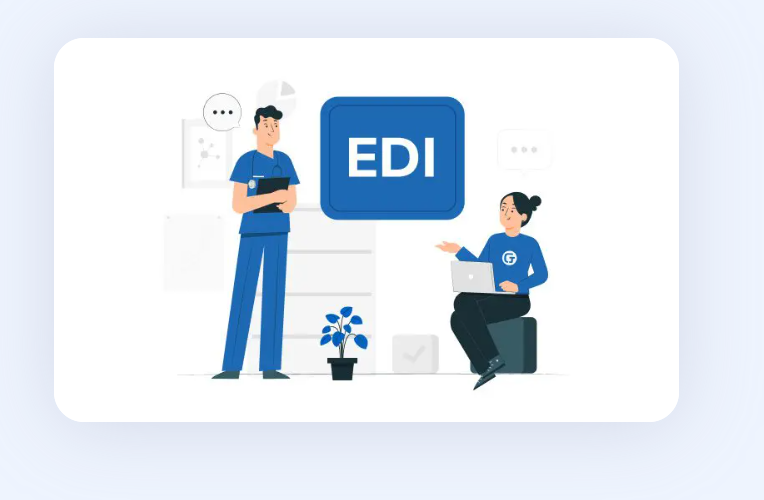The Evolution of EDI Transactions in Healthcare

In the intricate web of modern healthcare systems, efficiency, accuracy, and timeliness are paramount. With the ever-increasing volume of patient data and the complexity of medical procedures, it's imperative for healthcare providers to streamline their administrative processes. Enter Electronic Data Interchange (EDI) transactions – a revolutionary tool that has transformed the landscape of healthcare administration.
Understanding EDI Transactions
Electronic Data Interchange (EDI) transactions refer to the electronic exchange of structured data between computer systems. In the context of healthcare, EDI facilitates the seamless transmission of various administrative transactions, including claims submissions, eligibility inquiries, remittance advices, and more.
Streamlining Administrative Processes
Gone are the days of cumbersome paper-based documentation and manual data entry. EDI transactions automate administrative tasks, significantly reducing the potential for errors and expediting processing times. This streamlined approach not only enhances operational efficiency but also minimizes costs associated with manual labor and paper-based systems.
Ensuring Data Accuracy and Integrity
Accuracy is paramount in healthcare, where even the slightest error can have serious repercussions. EDI transactions enforce data integrity by eliminating transcription errors and ensuring consistency across systems. By adhering to standardized formats and protocols, EDI minimizes the risk of discrepancies and enhances the reliability of administrative data.
Enhancing Interoperability and Integration
Interoperability lies at the heart of modern healthcare systems, enabling seamless communication and collaboration between disparate entities. EDI transactions facilitate interoperability by providing a standardized framework for data exchange. Whether it's between healthcare providers, payers, or third-party vendors, EDI promotes integration, ensuring that crucial information flows smoothly across the healthcare ecosystem.
The Evolution of EDI in Healthcare
Over the years, EDI transactions have evolved in tandem with advancements in technology and regulatory requirements. From humble beginnings to sophisticated, interoperable systems, the evolution of EDI in healthcare has been marked by significant milestones and innovations.
Early Adoption and Standardization
The adoption of EDI in healthcare dates back to the late 20th century when pioneering organizations recognized its potential to revolutionize administrative processes. As the need for standardized data exchange became apparent, industry stakeholders collaborated to develop uniform standards such as the ANSI X12 and HL7. These standards laid the foundation for interoperability and paved the way for widespread EDI adoption across the healthcare landscape.
Integration with Electronic Health Records (EHRs)
With the widespread adoption of Electronic Health Records (EHRs), the integration of EDI transactions became increasingly vital. EHR systems serve as repositories for comprehensive patient data, making them ideal platforms for seamless EDI integration. By interfacing with EHRs, EDI transactions enable healthcare providers to streamline administrative workflows, from patient registration to claims processing, enhancing efficiency and accuracy throughout the care continuum.
Compliance and Regulatory Mandates
The healthcare industry is subject to stringent regulatory requirements aimed at safeguarding patient privacy and data security. EDI transactions play a crucial role in ensuring compliance with regulations such as the Health Insurance Portability and Accountability Act (HIPAA). By adhering to standardized formats and encryption protocols, EDI helps healthcare organizations safeguard sensitive information and mitigate the risk of data breaches.
Leveraging Emerging Technologies
As technology continues to evolve, so too does the landscape of EDI in healthcare. Emerging technologies such as blockchain and artificial intelligence hold the promise of further enhancing the efficiency and security of EDI transactions. Blockchain, with its immutable ledger and decentralized architecture, offers unparalleled transparency and security, making it an ideal platform for healthcare data exchange. Similarly, artificial intelligence algorithms can analyze vast amounts of EDI data, uncovering insights and patterns that can inform decision-making and improve outcomes.
The Future of EDI in Healthcare
As we look ahead, the future of EDI in healthcare appears promising, with continued advancements poised to drive innovation and efficiency across the industry.
Interoperability and Data Exchange
Interoperability remains a key focus area for healthcare stakeholders, with efforts underway to further standardize data exchange protocols and enhance compatibility between systems. By fostering seamless interoperability, EDI transactions will continue to facilitate the frictionless exchange of information, enabling care providers to deliver more coordinated and patient-centric services.
Enhanced Security and Compliance
In an era of heightened cybersecurity threats and regulatory scrutiny, the security of EDI transactions will remain paramount. Healthcare organizations will continue to invest in robust encryption protocols, authentication mechanisms, and audit trails to safeguard sensitive data and ensure compliance with evolving regulations.
Integration with Emerging Technologies
The integration of EDI with emerging technologies will open new frontiers in healthcare innovation. From leveraging blockchain for secure data exchange to harnessing artificial intelligence for predictive analytics, the convergence of EDI and cutting-edge technologies will drive transformative change, empowering healthcare providers to deliver more efficient, personalized, and cost-effective care.
In conclusion, EDI transactions in healthcare have emerged as a cornerstone of modern healthcare administration, enabling organizations to streamline processes, enhance data accuracy, and foster interoperability. As technology continues to evolve and regulatory requirements evolve, EDI will remain at the forefront of healthcare innovation, driving efficiency, security, and improved patient outcomes.
- Whats New
- Shopping
- Wellness
- Sports
- Theater
- Religion
- Party
- Networking
- Music
- Literature
- Art
- Health
- الألعاب
- Food
- Drinks
- Fitness
- Gardening
- Dance
- Causes
- Film
- Crafts
- Other/General
- Cricket
- Grooming
- Technology

